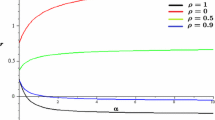Abstract
We consider a simple metapopulation model with explicit movement of individuals between patches, in which each patch is either a source or a sink. We prove that similarly to the case of patch occupancy metapopulations with implicit movement, there exists a threshold number of source patches such that the population potentially becomes extinct below the threshold and established above the threshold. In the case where the matrix describing the movement of populations between spatial locations is irreducible, the result is global; further, assuming a complete mobility graph with equal movement rates, we use the principle of equitable partitions to obtain an explicit expression for the threshold. Brief numerical considerations follow.





Similar content being viewed by others
References
Agaev R, Chebotarev P (2005) On the spectra of nonsymmetric Laplacian matrices. Linear Algebra Appl 399:157–168
Allen LJS (1987) Persistence, extinction, and critical patch number for island populations. J Math Biol 24(6):617–625
Amarasekare P (2004) The role of density-dependent dispersal in source-sink dynamics. J Theor Biol 226(2):159–168
Arditi R, Lobry C, Sari T (2015) Is dispersal always beneficial to carrying capacity? New insights from the multi-patch logistic equation. Theor Popul Biol 106:45–59
Arino J (2017) Spatio-temporal spread of infectious pathogens of humans. Infect Dis Model 2:218–228
Bansaye V, Lambert A (2013) New approaches to source-sink metapopulations decoupling demography and dispersal. Theor Popul Biol 88:31–46
Bascompte J (2003) Extinction thresholds: insights from simple models. Ann Zool Fennici 40:99–114
Bascompte J, Possingham H, Roughgarden J (2002) Patchy populations in stochastic environments: critical number of patches for persistence. Am Nat 159(2):128–137
Berman A, Plemmons RJ (1994) Nonnegative matrices in the mathematical sciences. Classics in applied mathematics, vol 9. SIAM, Philadelphia
Deutsch E, Neumann M (1985) On the first and second order derivatives of the Perron vector. Linear Algebra Appl 71:57–76
Dias PC (1996) Sources and sinks in population biology. Trends Ecol Evol 11(8):326–330
Eriksson O (1996) Regional dynamics of plants: a review of evidence for remnant, source-sink and metapopulations. Oikos 77:248–258
Evans SN, Ralph PL, Schreiber SJ, Sen A (2013) Stochastic population growth in spatially heterogeneous environments. J Math Biol 66(3):423–476
Fiedler M (2008) Special matrices and their applications in numerical mathematics, 2nd edn. Dover, New York
Godsil C, Royle GF (2013) Algebraic graph theory. Graduate texts in mathematics, vol 207. Springer, New York
Gravel D, Guichard F, Loreau M, Mouquet N (2010) Source and sink dynamics in meta-ecosystems. Ecology 91(7):2172–2184
Gyllenberg M, Hanski I (1997) Habitat deterioration, habitat destruction, and metapopulation persistence in a heterogenous landscape. Theor Popul Biol 52(3):198–215
Hanski I (1985) Single-species spatial dynamics may contribute to long-term rarity and commonness. Ecology 66(2):335–343
Hanski I (1991) Single-species metapopulation dynamics: concepts, models and observations. Biol J Linn Soc 42(1–2):17–38
Hastings A (1982) Dynamics of a single species in a spatially varying environment: the stabilizing role of high dispersal rates. J Math Biol 16(1):49–55
Hastings A (1991) Structured models of metapopulation dynamics. Biol J Linn Soc 42(1–2):57–71
Hirsch MW (1984) The dynamical systems approach to differential equations. Bull Am Math Soc 11(1):1–64
Holt RD (1985) Population dynamics in two-patch environments: some anomalous consequences of an optimal habitat distribution. Theor Popul Biol 28(2):181–208
Horn RA, Johnson CR (1991) Topics in matrix analysis. Cambridge University Press, Cambridge
Horn RA, Johnson CR (2013) Matrix analysis, 2nd edn. Cambridge University Press, Cambridge
Keymer JE, Marquet PA, Velasco-Hernández JX, Levin SA (2000) Extinction thresholds and metapopulation persistence in dynamic landscapes. Am Nat 156(5):478–494
Kuno E (1981) Dispersal and the persistence of populations in unstable habitats: a theoretical note. Oecologia 49(1):123–126
Levin SA (1974) Dispersion and population interactions. Am Nat 108(960):207–228
Levins R (1969) Some demographic and genetic consequences of environmental heterogeneity for biological control. Am Entomol 15(3):237–240
Lewontin RC, Cohen D (1969) On population growth in a randomly varying environment. Proc Natl Acad Sci 62(4):1056–1060
Matsumoto H, Seno H (1995) On predator invasion into a multi-patchy environment of two kinds of patches. Ecol Model 79(1):131–147
Metz JAJ, De Jong TJ, Klinkhamer PGL (1983) What are the advantages of dispersing: a paper by kuno explained and extended. Oecologia 57(1–2):166–169
Namba T (2007) Dispersal-mediated coexistence of indirect competitors in source-sink metacommunities. Jpn J Ind Appl Math 24(1):39–55
Pulliam HR (1988) Sources, sinks, and population regulation. Am Nat 132(5):652–661
Rael R, Taylor C (2018) A flow network model for animal movement on a landscape with application to invasion. Theor Ecol 11:271–280
Smith HL (1995) Monotone dynamical systems. Mathematical surveys and monographs, vol 41. American Mathematical Society, Providence
Takeuchi Y (1989) Cooperative systems theory and global stability of diffusion models. Acta Appl Math 14(1–2):49–57
Tromeur E, Rudolf L, Gross T (2016) Impact of dispersal on the stability of metapopulations. J Theor Biol 392:1–11
Varga RS (2010) Geršgorin and his circles. Springer, Berlin
Acknowledgements
JA and SK’s work is supported in part by NSERC. NB was supported by the Inria BIOCORE research team. The authors acknowledge comments by Matts Gyllenberg that helped tie this work with the existing literature. The authors thank an anonymous referee for helpful comments.
Author information
Authors and Affiliations
Corresponding author
Additional information
Publisher's Note
Springer Nature remains neutral with regard to jurisdictional claims in published maps and institutional affiliations.
Rights and permissions
About this article
Cite this article
Arino, J., Bajeux, N. & Kirkland, S. Number of Source Patches Required for Population Persistence in a Source–Sink Metapopulation with Explicit Movement. Bull Math Biol 81, 1916–1942 (2019). https://doi.org/10.1007/s11538-019-00593-1
Received:
Accepted:
Published:
Issue Date:
DOI: https://doi.org/10.1007/s11538-019-00593-1




